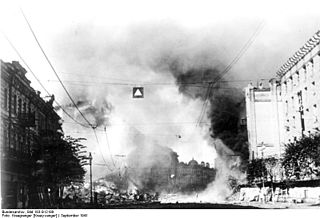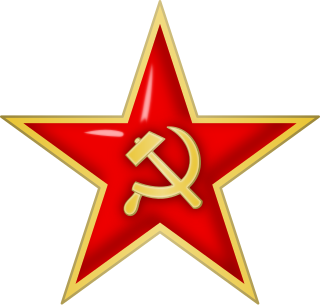Related Research Articles

The First Battle of Kiev was the German name for the operation that resulted in an encirclement of Soviet troops in the vicinity of Kiev during World War II. This encirclement is considered the largest encirclement in the history of warfare by number of troops. The operation ran from 7 July to 26 September 1941 as part of Operation Barbarossa, the Axis invasion of the Soviet Union.

The first Battle of Smolensk was a battle during the second phase of Operation Barbarossa, the Axis invasion of the Soviet Union, in World War II. It was fought around the city of Smolensk between 10 July and 10 September 1941, about 400 km (250 mi) west of Moscow. The Ostheer had advanced 500 km (310 mi) into the USSR in the 18 days after the invasion on 22 June 1941.

The Western Front was a front of the Red Army, one of the Red Army Fronts during World War II.

The second Smolensk operation was a Soviet strategic offensive operation conducted by the Red Army as part of the Summer-Autumn Campaign of 1943. Staged almost simultaneously with the Lower Dnieper Offensive, the offensive lasted two months and was led by General Andrei Yeremenko, commanding the Kalinin Front, and Vasily Sokolovsky, commanding the Western Front. Its goal was to clear the German presence from the Smolensk and Bryansk regions. Smolensk had been under German occupation since the first Battle of Smolensk in 1941.
The Soviet 21st Army was a field army of the Red Army during World War II.
The 7th Guards Cavalry Corps of the Soviet Union's Red Army was a cavalry corps active during the Second World War. It was formed from the 8th Cavalry Corps in February 1943.
The 32nd Cavalry Division was formed in 1938 in the Kiev Military District from the 1st Zaporozhe Cossack Cavalry Division.
The 43rd Cavalry Division was a cavalry division of the Red Army during World War II.
The 47th Cavalry Division was one of the first cavalry divisions formed after the start of the war. The unit was formed at Novocherkassk in the North Caucasus Military District from reservists and the cavalry depots in the district's cavalry training grounds.
The 52nd Cavalry Division was one of the first cavalry divisions formed after the start of the war. The unit was formed at Novocherkassk in the North Caucasus Military District likely from the reservists and cavalry depots in the district's cavalry training grounds.
The 18th Mountain Cavalry Division was formed in 1936 by renaming the 7th Tadzhik Mountain Cavalry Division in the Central Asia Military District.
The 42nd Rifle Division was a unit of the Red Army during the Great Patriotic War. The division, first formed in 1940, was nearly destroyed in the opening days of the Operation Barbarossa defending the Brest Fortress. Disbanded in late December 1941 and immediately reformed in the Volga Military District. The division then served on the front until disbanded at the end of the war.

The 112th Infantry Division was a German Army infantry division active in World War II.
The 67th Rifle Corps was a corps of the Red Army during World War II, formed twice.
The Roslavl–Novozybkov offensive was an offensive conducted by the Red Army's Bryansk Front against the German 2nd Panzer Group and 2nd Army in Bryansk Oblast and parts of Sumy Oblast on the Eastern Front of World War II between 30 August and 12 September 1941, part of the Battle of Smolensk in Soviet historiography.

The Khopyor–Don Operation was an offensive during the Russian Civil War of the 9th Army of the Southeastern Front of the Red Army, reinforced by the Cavalry Corps of the 10th Army, against the forces of the Don Army, in order to ensure the stability of the left wing of the Southern Front of the Red Army and reach the Don River.
The 22nd Guards Rifle Division was unique in being the only Guards rifle division formed twice during the Great Patriotic War. It was first formed from the 363rd Rifle Division in March 1942. Soon after forming it provided a command cadre for the second formation of the 53rd Army in Kalinin Front. Later, in the fall of that year, the division provided most of its personnel and equipment to form the new 2nd Guards Mechanized Corps, and was then disbanded. In April 1943, a new 22nd Guards was formed from the second formation of the 150th Rifle Division in the Moscow Military District, and went on to serve for the duration in 10th Guards Army. This formation first saw service in Operation Suvorov, the summer offensive of Western Front that liberated Smolensk in late September, and then fought through the autumn and winter in grinding battles towards the city of Orsha. During the summer offensive of 1944 it helped break the Panther Line in western Russia and then advanced into Latvia, winning a battle honor for its part in the liberation of Riga, before ending the war in Lithuania, helping to contain the German forces trapped in the Courland Pocket. It was disbanded shortly after the war.
The 65th Guards Rifle Division was formed as an elite infantry division of the Red Army in May, 1943, based on the 2nd formations of the 75th and 78th Rifle Brigades, and served in that role until after the end of the Great Patriotic War. Along with its "sister", the 56th Guards Rifle Division, the 65th was formed "out of sequence", that is, many Guards rifle divisions were higher numbered and formed earlier than the 65th. The division was immediately assigned to the 19th Guards Rifle Corps of the 10th Guards Army and remained under those headquarters for the duration of the war. It first saw action in Western Front's summer offensive, Operation Suvorov. During the winter of 1943-44 it took part in the stubborn fighting north and east of Vitebsk, first in Western and later in 2nd Baltic Front. During the following summer offensives it helped break through the defenses of the German Panther Line and advanced into the Baltic states, eventually receiving a battle honor for its part in the liberation of Riga. For the rest of the war it was part of the forces blockading the remnants of German Army Group North in the Courland Pocket in Latvia, eventually in Leningrad Front. After the war the 65th Guards was moved to Estonia where it was disbanded in 1947.
The 222nd Rifle Division was an infantry division of the Red Army, originally formed in the months just before the start of the German invasion, based on the shtat of September 13, 1939. It was formed at Starodub and was considered a "sister" to the 217th Rifle Division. It first saw action in July 1941 as part of 28th Army in the fighting between Smolensk and Roslavl and the division took heavy casualties when it was partly encircled and forced to abandon the latter city in early August. It was again encircled during Operation Typhoon but managed to escape complete destruction and soon came under command of 33rd Army, where it remained for almost the entire length of the war.
The 229th Rifle Division was an infantry division of the Red Army, originally formed in the months just before the start of the German invasion, based on the shtat of September 13, 1939. As part of 20th Army it was moved from the Moscow Military District to the front west of Orsha by July 2. Serving under the Western Front the 20th was soon pocketed in the Smolensk region but the 229th was able to escape at the cost of significant losses. It was partially rebuilt before the start of the final German offensive on Moscow, when it was completely encircled and destroyed.
References
- ↑ Sharp, Charles (1995). Red Sabers. Nafizger Press.
See also Cavalry corps (Red Army)